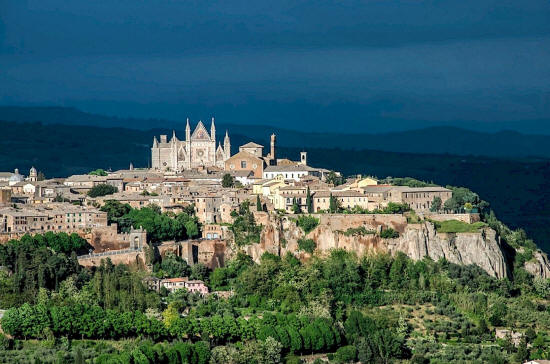
|
The larger cities of Umbria all have a Tourist Information Office near the centre of the city. In smaller places, look for the ProLoco Office which serves the same purpose. All of these offices have maps and a range of brochures describing local sights of interest and bus routes. Umbria is one of the twenty Regions of Italy. It shares a border with Tuscany to the west and the north, with Le Marche to the east and with Lazio to the south. Parts of Umbria are flat and fertile, mostly in the valley of the Tiber, while the area of the central Apennines in Umbria is mountainous. The highest point in Umbria is Monte Vettore (2,476 metres - 8,123 feet), located on the border of Le Marche. Fioritura of Castelluccio di Norcia, Umbria This geomorphological variation together with the presence of Lake Trasimeno and of hillside and hilltop towns - notably Orvieto, perched on top of a high, flat-topped rocky outcrop - makes the landscape of Umbria extraordinarily varied and attractive. The range of altitudes means that there are sights of interest in Umbria with pleasant climatic conditions for visitors throughout the Spring, Summer and Autumn. Among the things to see in Umbria, the “Fiorita” or “Fioritura” of Castelluccio di Norcia ranks high. The famous red poppies to be seen during Spring in the Val d'Orcia of Tuscany are a comparable sight but nowhere near as spectacular as the multicoloured spectacle of millions of alpine flowers bursting into bloom on the Pain Grande of the Castelluccio di Norcia between the end of May and the beginning of July of each year. More about the sights of Umbria.
Interior of the Duomo of Spoleto, Umbria Umbria is home to several major "art cities" and a great many smaller places that are home to major art works, many of them the fruit of the Umbrian Renaissance whose most famous artists were Perugino and Pintoricchio. In addition to paintings and frescoes, the sights of the cities and towns of Umbria include beautiful civic structures, churches and monasteries. As elsewhere in Italy, the fragmentation of the Italic peninsula into myriad independent cities, Duchies and other political nuclei in past centuries resulted in intense competition, not least in the artistic sphere where civic prestige was enormously enhanced by the erection of magnificent churches, palazzi and town halls, and the display of fine works of art, principally frescoes, paintings and sculpture. More about the art cities of Umbria.
Porchetta from Norcia, Umbria Umbria is also famous for its cuisine, especially its truffles, lentils and pork products, all of which are well-represented in the town of Norcia. A very popular black truffle festival takes place in Norcia every year. More about the gustatory
delights of
Norcia.
|
Umbria Tourist Information Copyright © ammonet InfoTech 2020 - 2021. All rights reserved.